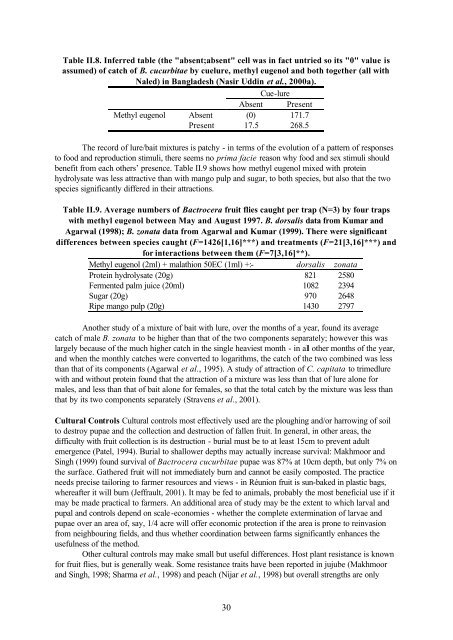“Key Informant Survey” of Production, Value, Losses and ... - DfID
“Key Informant Survey” of Production, Value, Losses and ... - DfID
“Key Informant Survey” of Production, Value, Losses and ... - DfID
Create successful ePaper yourself
Turn your PDF publications into a flip-book with our unique Google optimized e-Paper software.
Table II.8. Inferred table (the "absent;absent" cell was in fact untried so its "0" value is<br />
assumed) <strong>of</strong> catch <strong>of</strong> B. cucurbitae by cuelure, methyl eugenol <strong>and</strong> both together (all with<br />
Naled) in Bangladesh (Nasir Uddin et al., 2000a).<br />
Cue-lure<br />
Absent Present<br />
Methyl eugenol Absent (0) 171.7<br />
Present 17.5 268.5<br />
The record <strong>of</strong> lure/bait mixtures is patchy - in terms <strong>of</strong> the evolution <strong>of</strong> a pattern <strong>of</strong> responses<br />
to food <strong>and</strong> reproduction stimuli, there seems no prima facie reason why food <strong>and</strong> sex stimuli should<br />
benefit from each others’ presence. Table II.9 shows how methyl eugenol mixed with protein<br />
hydrolysate was less attractive than with mango pulp <strong>and</strong> sugar, to both species, but also that the two<br />
species significantly differed in their attractions.<br />
Table II.9. Average numbers <strong>of</strong> Bactrocera fruit flies caught per trap (N=3) by four traps<br />
with methyl eugenol between May <strong>and</strong> August 1997. B. dorsalis data from Kumar <strong>and</strong><br />
Agarwal (1998); B. zonata data from Agarwal <strong>and</strong> Kumar (1999). There were significant<br />
differences between species caught (F=1426[1,16]***) <strong>and</strong> treatments (F=21[3,16]***) <strong>and</strong><br />
for interactions between them (F=7[3,16]**).<br />
Methyl eugenol (2ml) + malathion 50EC (1ml) +:- dorsalis zonata<br />
Protein hydrolysate (20g) 821 2580<br />
Fermented palm juice (20ml) 1082 2394<br />
Sugar (20g) 970 2648<br />
Ripe mango pulp (20g) 1430 2797<br />
Another study <strong>of</strong> a mixture <strong>of</strong> bait with lure, over the months <strong>of</strong> a year, found its average<br />
catch <strong>of</strong> male B. zonata to be higher than that <strong>of</strong> the two components separately; however this was<br />
largely because <strong>of</strong> the much higher catch in the single heaviest month - in all other months <strong>of</strong> the year,<br />
<strong>and</strong> when the monthly catches were converted to logarithms, the catch <strong>of</strong> the two combined was less<br />
than that <strong>of</strong> its components (Agarwal et al., 1995). A study <strong>of</strong> attraction <strong>of</strong> C. capitata to trimedlure<br />
with <strong>and</strong> without protein found that the attraction <strong>of</strong> a mixture was less than that <strong>of</strong> lure alone for<br />
males, <strong>and</strong> less than that <strong>of</strong> bait alone for females, so that the total catch by the mixture was less than<br />
that by its two components separately (Stravens et al., 2001).<br />
Cultural Controls Cultural controls most effectively used are the ploughing <strong>and</strong>/or harrowing <strong>of</strong> soil<br />
to destroy pupae <strong>and</strong> the collection <strong>and</strong> destruction <strong>of</strong> fallen fruit. In general, in other areas, the<br />
difficulty with fruit collection is its destruction - burial must be to at least 15cm to prevent adult<br />
emergence (Patel, 1994). Burial to shallower depths may actually increase survival: Makhmoor <strong>and</strong><br />
Singh (1999) found survival <strong>of</strong> Bactrocera cucurbitae pupae was 87% at 10cm depth, but only 7% on<br />
the surface. Gathered fruit will not immediately burn <strong>and</strong> cannot be easily composted. The practice<br />
needs precise tailoring to farmer resources <strong>and</strong> views - in Réunion fruit is sun-baked in plastic bags,<br />
whereafter it will burn (Jeffrault, 2001). It may be fed to animals, probably the most beneficial use if it<br />
may be made practical to farmers. An additional area <strong>of</strong> study may be the extent to which larval <strong>and</strong><br />
pupal <strong>and</strong> controls depend on scale-economies - whether the complete extermination <strong>of</strong> larvae <strong>and</strong><br />
pupae over an area <strong>of</strong>, say, 1/4 acre will <strong>of</strong>fer economic protection if the area is prone to reinvasion<br />
from neighbouring fields, <strong>and</strong> thus whether coordination between farms significantly enhances the<br />
usefulness <strong>of</strong> the method.<br />
Other cultural controls may make small but useful differences. Host plant resistance is known<br />
for fruit flies, but is generally weak. Some resistance traits have been reported in jujube (Makhmoor<br />
<strong>and</strong> Singh, 1998; Sharma et al., 1998) <strong>and</strong> peach (Nijar et al., 1998) but overall strengths are only<br />
30

















